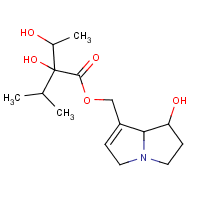Rinderine
Agent Name
Rinderine
CAS Number
6029-84-1
Formula
C15-H25-N-O5
Major Category
Biological Agents

Synonyms
Butanoic acid, 2,3-dihydroxy-2-(1-methylethyl)-, (2,3,5,7a-tetrahydro-1-hydroxy-1H-pyrrolizin-7-yl)methyl ester, (1S-(1alpha,7(2R*,3S*),7aalpha))-; [ChemIDplus]
Category
Plant Toxins
Sources/Uses
More than 350 pyrrolizidine alkaloids (PAs) in over 6000 plants have been identified. They are probably the most common cause of plant poisoning in the world and affect livestock, wildlife, and humans. They are found in the Boraginaceae, Compositae, and Leguminosae families and are commonly encountered in the following plants: fiddle neck, tarweed, rattle box, blue weed, giant hog weed, heliotrope, groundsels, Senecio, and comfrey. [Haddad, p. 494] Liver disease from "bush tea" derived from the Crotalaria plant is endemic in Jamaica. Cereal contaminated with PA seeds (Heliotropium and Crotalaria) have caused epidemics in Afghanistan and India. Herbal remedies that have caused liver disease include Senecio and comfrey. [Goldfrank, p. 647]
Comments
Emergency treatment: "Plants- pyrrolizidine alkaloids"; Pyrrolizidine alkaloids (PAs) cause veno-occlusive liver disease. Diagnosis is difficult because symptoms may be delayed for days or weeks. After drinking herbal tea or eating plants contaminated with seeds of PA plants, symptoms may include vomiting, abdominal pain, hepatomegaly, and later ascites. Jaundice may be present. Children may appear to have Reye's syndrome. [HSDB] Teas containing PAs include coltsfoot, comfrey, gordolobo, groundsel, mate, tansy ragwort, and T'u-san-chi. The teas may be prescribed as herbal remedies for anxiety or amenorrhea. The alkaloid is concentrated in the root of the plants. As little as 85 mg may be toxic. [Haddad, p. 1082] PAs also cause cirrhosis and possibly hepatic carcinoma. [Goldfrank, p. 647]
Biomedical References
Adverse Effects
Hepatotoxin
Hepatoxic (a) from occupational exposure (secondary effect) or (b) in animal studies or in humans after ingestion
Diseases, Processes, and Activities Linked to This Agent
Other Information
No other related information on this agent was found.